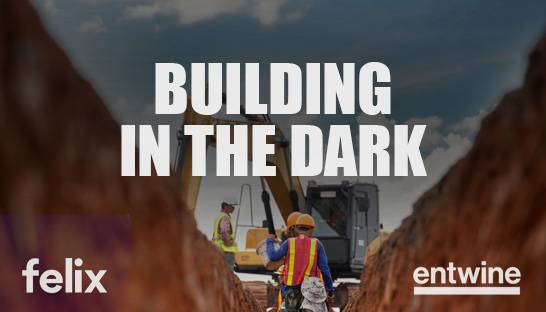As Australia reopens and adjusts to a new Covid-19-reality, the construction industry is earmarked to play a significant role in economic recovery. The Australian government’s $110 billion infrastructure spend and financial support of the residential construction sector highlight this well.
However, with all construction booms comes additional risk for the sector, which can erode the economic benefits sought if ignored. Skill shortages and material cost escalation are just some of the challenges that can undo a project – or worse – in any boom, never mind one occurring within the context of an ongoing pandemic.
It is well known how Covid-19 has disrupted supply chains across construction to an extreme extent.

This disruption has also highlighted just how reliant the industry is on outsourcing and the complex global supply chains in play. Yet this supply ‘network’ also comes laden with risks, many of which are not always immediately visible or easily addressable.
With every network comes risk: Supply chain risk
Last year Felix, a leading enterprise procurement platform, commissioned boutique construction consultancy entwine to research this issue of supply chain risk. The findings are available in the recently released report ‘Building in the Dark’ and make for interesting, albeit, at times alarming, reading.
First, there is the issue of industry context. Based on industry feedback, industry reality is one of increasingly more complicated projects, commercial arrangements, and compliance requirements. Often, there is difficulty sourcing eligible parties, an issue that mandates on labour force demographic can further complicate.

Yet while organisations understand how critical external parties are to the success of their projects, they appear much less aware of the full spectrum of risks associated with them. To create awareness, organisations must first identify the parties in their networks. Yet, the report findings suggest organisations do not know their supply networks well. Only 11% of participants in the report were fully confident in their organisation’s ability to name every party in its supply chain.
Furthermore, construction work streams are characterised by subcontractors engaged for technically complex, high-risk work packages. Yet, over half of those surveyed (56%) believed their organisation to have unknowingly engaged a supplier red-flagged by another area of the organisation.
The stakes are higher than ever
While there is a recognition of certain risks outside the traditional paradigm of time, cost and quality, including modern slavery, fraud, corruption, or the black economy, these remain deprioritised against the ‘here and now’ of immediate project delivery – programme can even trump quality.

Many players remain in the dark about what is at stake and the efforts required for fit-for-purpose supply chain risk management strategies. 67% of industry professionals surveyed believed that clients or project sponsors do not understand the true cost of effectively managing third-party risk.
Yet, the lack of vital information-sharing that underpins effective supply chain risk management can lead to heavy losses and sub-par outcomes for the projects rolling out across the country. Early warning of potential issues can be all that is needed to avoid detrimental consequences but is contingent on solid communication.
In addition, findings suggest that risks are often transferred to parties not fully equipped to manage them. 79% of industry players surveyed believed their third parties were not always fully aware of or understood the risks they were responsible for managing under their contracts.
The impacts of this issue are compounded by low levels of transparency and monitoring of third parties. In effect, many organisations are consciously operating in relative ignorance of the actions of their suppliers not directly managed on the job site and thus remaining in the dark concerning the management of multiple risks.

Technology adoption key driver for risk management
With greater visibility of the network, comes improved risk management – this yields better outcomes across multiple measures – efficiency of delivery, quality of asset, a more ethical industry – all wins for Australia, and beyond.
This visibility hinges on more effective and efficient communication and information sharing, both within and between organisations – credible information flows are what establish the quality of both the supplier and its extended supply chains before and after contract award.
Simple examples include streamlining the due diligence required around insurances, financial position, and external accreditations before contract award and then offering a mechanism not so contingent on ‘people-power’ to keep on top of these issues during contract execution.
Technology advancements now allow organisations to inject greater transparency and accountability into the supply chain by enabling large volumes of information to be efficiently obtained, analysed, and monitored. Digital solutions can also provide shared online spaces to identify and manage ongoing risks associated with the network where the cost burden would be prohibitive if borne by single projects.
However, while many organisations recognise the value of going digital, over half (56%) of the research participants believed their organisations were not investing enough in digital tools.
This lag in adoption prompted a joint Felix and entwine submission to the recent Parliamentary inquiry into procurement practices. This submission outlined strong recommendations for digitisation to promote increased efficiency and effectiveness in supplier due diligence and ongoing monitoring, thus modernising procurement within acknowledged capacity constraints.
A call for action
The industry landscape has shifted dramatically in recent years, and the risks lying in construction supply chains are multifaceted and complex. There is a need for a better handle on supply chain risk management and mitigation.
To this end, leadership in construction at all levels of industry need to ensure they have adequate systems to drive transparency, accountability and sustainability throughout their supply chains as we embark on an unprecedented level of building and infrastructure.
Grab your copy of the Building in The Dark report.
Originally published on Consultancy.com.au

Recent Articles
2025 in review: Milestones, insights and achievements
2025 – a year of that brought meaningful developments for Felix as we continue to address the evolving needs of organisations navigating complex supply-chain environments.
Top 10 reasons for a centralised vendor database
As organisations grow, so does the complexity of managing vendor relationships. Many still rely on spreadsheets or siloed systems, which can lead to inefficiencies, data inconsistencies, and compliance risks. A centralised vendor database offers a smarter, more scalable solution that brings structure, visibility, and control to procurement operations.
Here are the top 10 reasons why centralising your vendor data is a strategic move.
Five ways poor contract storage could be costing your organisation money
Contracts are the backbone of every business relationship – legally binding documents that define expectations, responsibilities, and value.
But what if the way your organisation stores those contracts is quietly costing you money?
Let's stay in touch
Get the monthly dose of supply chain, procurement and technology insights with the Felix newsletter.






